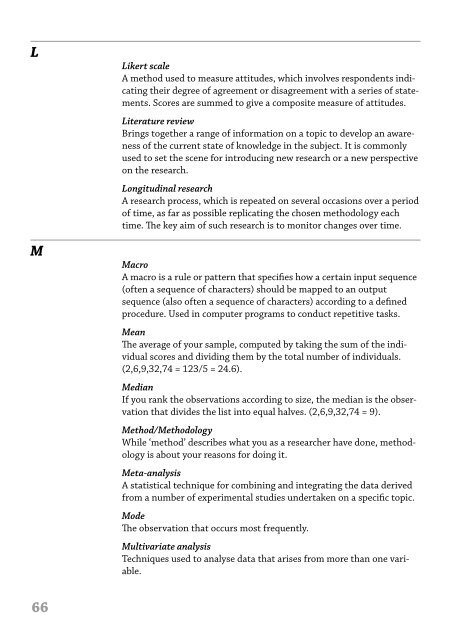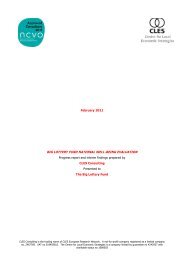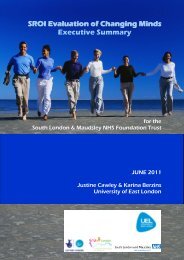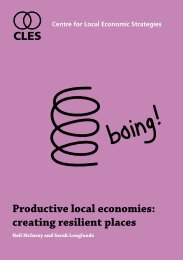Research Methods Handbook.pdf - CLES
Research Methods Handbook.pdf - CLES
Research Methods Handbook.pdf - CLES
Create successful ePaper yourself
Turn your PDF publications into a flip-book with our unique Google optimized e-Paper software.
LMLikert scaleA method used to measure attitudes, which involves respondents indicatingtheir degree of agreement or disagreement with a series of statements.Scores are summed to give a composite measure of attitudes.Literature reviewBrings together a range of information on a topic to develop an awarenessof the current state of knowledge in the subject. It is commonlyused to set the scene for introducing new research or a new perspectiveon the research.Longitudinal researchA research process, which is repeated on several occasions over a periodof time, as far as possible replicating the chosen methodology eachtime. The key aim of such research is to monitor changes over time.MacroA macro is a rule or pattern that specifies how a certain input sequence(often a sequence of characters) should be mapped to an outputsequence (also often a sequence of characters) according to a definedprocedure. Used in computer programs to conduct repetitive tasks.MeanThe average of your sample, computed by taking the sum of the individualscores and dividing them by the total number of individuals.(2,6,9,32,74 = 123/5 = 24.6).MedianIf you rank the observations according to size, the median is the observationthat divides the list into equal halves. (2,6,9,32,74 = 9).Method/MethodologyWhile ‘method’ describes what you as a researcher have done, methodologyis about your reasons for doing it.Meta-analysisA statistical technique for combining and integrating the data derivedfrom a number of experimental studies undertaken on a specific topic.ModeThe observation that occurs most frequently.Multivariate analysisTechniques used to analyse data that arises from more than one variable.NONaturalistic paradigmThis paradigm assumes that there are multiple interpretations of realityand that the goal of researchers working within this perspective is tounderstand how individuals construct their own reality within theirsocial context.Nominal scaleA nominal scale is one that allows the researcher to assign subjectsto certain categories or groups. For example, with variable of gender,respondents can be grouped into two categories male and female. Thesetwo groups can be assigned code numbers 0 and 1.Normal distributionA theoretical frequency distribution for a set of variable data, usuallyrepresented by a bell-shaped curve symmetrical about the mean. Statisticiansand mathematicians uniformly use the term “normal distribution”while physicists sometimes call it a Gaussian distribution.Null HypothesisThe prediction that there is no relationship between your treatmentand your outcome.Ordinal VariableVariables with an ordered series, e.g. “very poor, poor, no opinion,good, very good”. Numbers assigned to such variables indicate rankorder only, the “distance” between the numbers has no meaning.PPanel studiesPanel studies measure the same sample of respondents at differentpoints in time.ParadigmA philosophical and theoretical framework of a scientific school ordiscipline within which theories, laws, and generalisations and theexperiments performed in support of them are formulated.ParameterA quantity (such as the mean or variance) that characterises a statisticalpopulation and that can be estimated by calculations from sampledata.66 67









